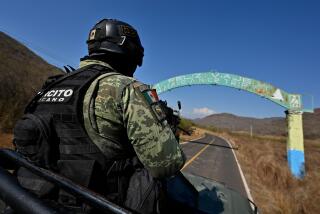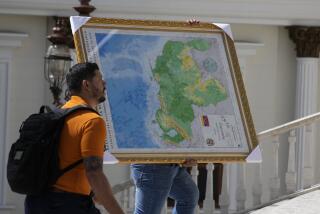Arrival of Green Beret Trainers Sets Off Costa Rican Debate on Military
SAN JOSE, Costa Rica â The arrival of a U.S. Army Special Forces team to train Costa Rican civil guardsmen has triggered a blaze of verbal sniping in this peaceful Central American country.
Perennial gadfly and former President Jose (Pepe) Figueres is among the most prominent critics of the military training, scheduled to start this week. âIt tends to increase our difficulties with our neighbor, Nicaragua,â Figueres said in an interview.
Also at issue is a sacrosanct civic tradition started under Figueresâ leadership: Since the late 1940s, Costa Rica has been proud to call itself a nation without an army.
Figueres and other Costa Ricans charge that U.S. military aid and training threaten to transform the Civil Guard from a police force into an army. The government denies that the Civil Guard is being militarized but insists that the force must be prepared to defend the country.
Allergy to Military
Costa Ricaâs allergy to things military dates back to a short civil war fought by a rebel army and government forces in 1948. Figueres, now 78, headed the civilian junta that emerged from that conflict.
âI disbanded both armies and introduced the constitutional prohibition of armed forces,â Figueres proudly recalled this weekend.
The slightly built former president wore a green eyeshade and a loose, light-blue guayabera shirt. Rain fell outside his chalet in green hills above San Jose as he reflected on the anti-military path his country chose.
It has worked, he said: International support--not an army--turned back Nicaraguan attacks on Costa Rica in 1948 and 1955.
Figueres followed the anti-military tradition as Costa Ricaâs elected president in 1953-1958 and 1970-1974. Now, he said, the Reagan Administration is pushing his National Liberation Party, currently in power again, to rearm the country.
President Luis Alberto Monge complains privately of American pressure on him to accept military aid and training, according to Figueres. He said that to get desperately needed economic aid from Washington, Monge accepts the military assistance.
He contended that the United States wants to draw Costa Rica into its campaign against the Marxist-led Sandinista government of Nicaragua.
The military training âis an anti-Sandinista measure and a further corruption of Costa Rica,â Figueres said. âBy corruption I mean militarization.â
Public Security Minister Benjamin Piza, who is responsible for the Civil Guard, denied that Washington has pressured Costa Rica to take military trainers.
âNor would they be accepted here if there were pressures,â Piza said in his office Friday.
He said the training is necessary to guard against Marxist expansionism from Nicaragua.
âWe have the right and the obligation to be prepared to defend ourselves,â he said, ânot only against foreign attacks, but from possible domestic uprisings.â
Insurgency is a threat âbecause of the decided and open participation of the Sandinista government in Marxism-Leninism and its exportation of revolution,â Piza said.
In a press conference earlier last week, President Monge criticized those who âprotest whenever we buy a bullet.â
âIn the face of an eventual foreign aggression--which wonât be with pop-bottle rockets but with tanks--we have to prepare to defend ourselves,â he said.
The training program that starts this week is not the first to be conducted in Costa Rica by U.S. military personnel, but it apparently is the biggest. A 22-member Special Forces team will train 750 guardsmen in military-style operations.
Five smaller U.S. training teams have come to Costa Rica since 1981, when American military assistance to the country began, a U.S. Embassy spokesman said.
The new training program will take place at a Civil Guard camp at Murcielago, near the Pacific Coast about 12 miles south of the Nicaraguan border. The camp was built with U.S. aid on what once was a ranch called El Murcielago (The Bat) that belonged to Nicaraguan strongman Anastasio Somoza.
Somoza was overthrown by the Sandinistas in 1979.
Arrival of Green Berets
The first 15 of the Green Beret trainers arrived Wednesday from Panama on an Air Force C-130 transport plane, landing on an airfield at Liberia in northern Costa Rica.
Leftist members of the national Legislative Assembly immediately presented a motion calling for a debate on why the plane came without permission from the assembly. The Costa Rican constitution says it is up to the assembly âto give or not give its consent for the entry of foreign troops into national territory.â
The government maintains that unarmed military trainers are not troops.
âThey are troops, whatever their number, they are military troops,â argued Miguel Angel Guillen, a member of Mongeâs party in the assembly.
Thursday night in the assembly, a dispute on the issue turned into a disorderly shouting match. More polemics are expected this week.
Assembly member Ricardo Rodriguez, a leftist independent, said in an interview that the 22 U.S. Army trainers could open the door to a major American military presence in Costa Rica.
âCosta Ricans, without realizing it, could not only have an army but could also become dangerously caught up in the Central American conflict,â Rodriguez said.
The American trainers, he said, âare an absolute contradiction to the governmentâs neutrality policyâ and could provoke difficulties on the borderâ between Nicaragua and Costa Rica.
In 1983, Monge proclaimed Costa Ricaâs âperpetual, active and unarmed neutrality.â
Danilo Chaverri, leader in the assembly of the opposition Social Christian Unity Party, called for âvigilanceâ to prevent âthe development of a defense force that could endanger the democratic balanceâ of the country.
The newspaper La Republica said that a survey of union leadersâ opinions on the presence of the U.S. trainers revealed âa wave of negative reaction.â
Costa Ricaâs Civil Guard, a uniformed police force responsible for security in urban areas and on national borders, has about 4,000 armed members. The Rural Guard, a similar body that enforces the law in the countryside, also is about 4,000-strong.
Old Weapons Replaced
Both forces are used for political patronage. When a party takes power, it changes the guard, handing out police jobs to its supporters.
Regardless of rank, guard members receive a base salary of about $140 a month. They can quit whenever they wish.
While the Rural Guard still uses World War II-era M-1 carbines, the Civil Guard is being re-equipped with automatic rifles, including U.S.-made M-16s and Israeli-made Galils.
Hundreds of civil guardsmen received military training at the U.S. Armyâs School of the Americas in Panama before the school was moved out of Panama last year. Hundreds more have been trained in Costa Rica by U.S. military instructors.
An anti-terrorist unit of about 100 men was trained by Israeli instructors about two years ago. All but 15 later dropped out of the Civil Guard, most of them taking higher-paid jobs as private security agents, Security Minister Piza said.
He said that the anti-terrorist unitâs strength has been brought back up to about 40, and it has been retrained this year by American military instructors.
Piza said that 20 guardsmen a year go to Taiwan for courses in political warfare.
This year, 43 officers went to Honduras for training by U.S. Army Special Forces instructors. Those 43 will be the officer corps for the 750 guardsmen whose training starts this week.
The program will include instruction in communications, transportation, logistics, patrolling, night navigation, light arms, anti-insurgency and explosives, Piza said.
More to Read
Sign up for Essential California
The most important California stories and recommendations in your inbox every morning.
You may occasionally receive promotional content from the Los Angeles Times.










